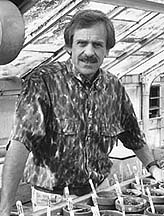Edwin Florance

Florance procured the College’s first scanning electron microscope from the U.S. Forest Service in 1986. The shortcomings of that early-generation device led Florance to apply to the National Science Foundation in 1992 for grant money to purchase a newer model. He titled the successful $90,000 request “Seeing Is Believing.”
“Visual images play a tremendous role in the biological sciences,” Florance explains. “If you understand the process by which the data is produced, it greatly enhances your ability to interpret and understand the images.”
One of the preeminent research tools employed by biologists is the scanning electron microscope, which uses electrons to produce images of higher magnification (up to 500,000 times actual size), greater resolution and depth of focus than a traditional light microscope. It is a fundamental tool of structural biology, which examines the interface between form and function, and is used by medical researchers, forensic scientists, metallurgists, and computer technicians, among other professionals.
“There’s hardly a field in the biological sciences where microscopy doesn’t come into play,” says Florance, who has relied heavily on scanning electronic microscopes during his 25-year career at Lewis & Clark, most recently in his efforts to save threatened and endangered plant species. The scanning electron microscope allows him to examine seed structures for clues on how to induce germination.
As part of the 1992 grant application, Florance developed a hands-on project for an introductory biology course that took advantage of the microscope’s capabilities. First, three-person teams propose a question to analyze, such as whether a grain’s structure can serve as a marker for a family of pollen, or how bone structure differs among animal species. Then, after researching the subject and collecting data with light microscopes, students use the scanning electron microscope to gather key data and write a final paper.
Other students and faculty members use the microscope as well, gaining valuable experience that has helped vault Lewis & Clark graduates into promising research and technical posts at Oregon Health & Science University, Intel, and Oregon State University, to name a few.
The captivating close-ups produced by the scanning electron microscope alone might propel more students into the field. “Doing structural biology is like exploring inner space, as opposed to outer space,” Florance tells his students. Of the two, he would argue, inner space is definitely the more fascinating.
—by Dan Sadowsky
More L&C Magazine Stories
Lewis & Clark Magazine is located in McAfee on the Undergraduate Campus.
MSC: 19
email magazine@lclark.edu
voice 503-768-7970
fax 503-768-7969
The L&C Magazine staff welcomes letters and emails from readers about topics covered in the magazine. Correspondence must include your name and location and may be edited.
Lewis & Clark Magazine
Lewis & Clark
615 S. Palatine Hill Road MSC 19
Portland OR 97219

